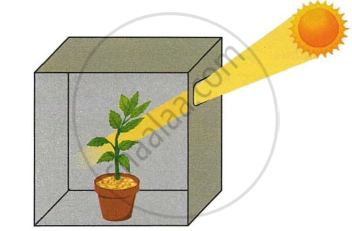Advertisements
Advertisements
Question
What happens to the moonflower
- during the daytime, and
- at night?
What is this phenomenon known as?
Solution
- The petals of a moonflower close during the day.
- They open during the night.
This phenomenon is known as photonasty.
APPEARS IN
RELATED QUESTIONS
Give the scientific terms used to represent the Bending of a shoot towards light.
Plant parts show two types of movements, one dependent on growth and other independent of growth Give one example which depends on growth
Define chemotropism.
Why is the closing of a dandelion flower at dusk (when it gets dark) not a tropism?
To which of the following directional stimulus roots of a plant do not respond?
A potted plant is growing in a transparent glass jar. In this plant, X and Y are the two growing parts having a lot of meristematic tissue. It is observed that the part X of this plant exhibits positive geotropism but negative phototropism. On the other hand, part Y of this plant exhibits negative geotropism but positive phototropism.
(a) Name the part X of plant.
(b) Name the part Y of plant.
(c) Which part of the plant, X or Y, will exhibit positive hydrotropism?
(d) Which part of the plant, X or Y, can have tendrils on it?
(e) Which phytohormone causes the part X to exhibit negative phototropism?
The petals of the moon flower open up in the morning and close in the evening. This is called photo nasty.
Which parts of a plant exhibit Positive hydrotropism?
Name the stimulus which causes the following movement in plant:
Geotropism
The figure given below depicts a kind of tropic movement in plants. Study the same and answer the following questions:

- What kind of a movement is shown in the figure? Define it.
- How does this movement differ from geotropism?
- Name the stimulus responsible for thigmotropism. Give one example of a plant showing thigmotropism.
- Name one stimulus which gives a positive response for the roots but a negative response for the shoot.
- Draw a neat and labelled diagram of the part of a plant showing leaf tendril. Name the plant.
